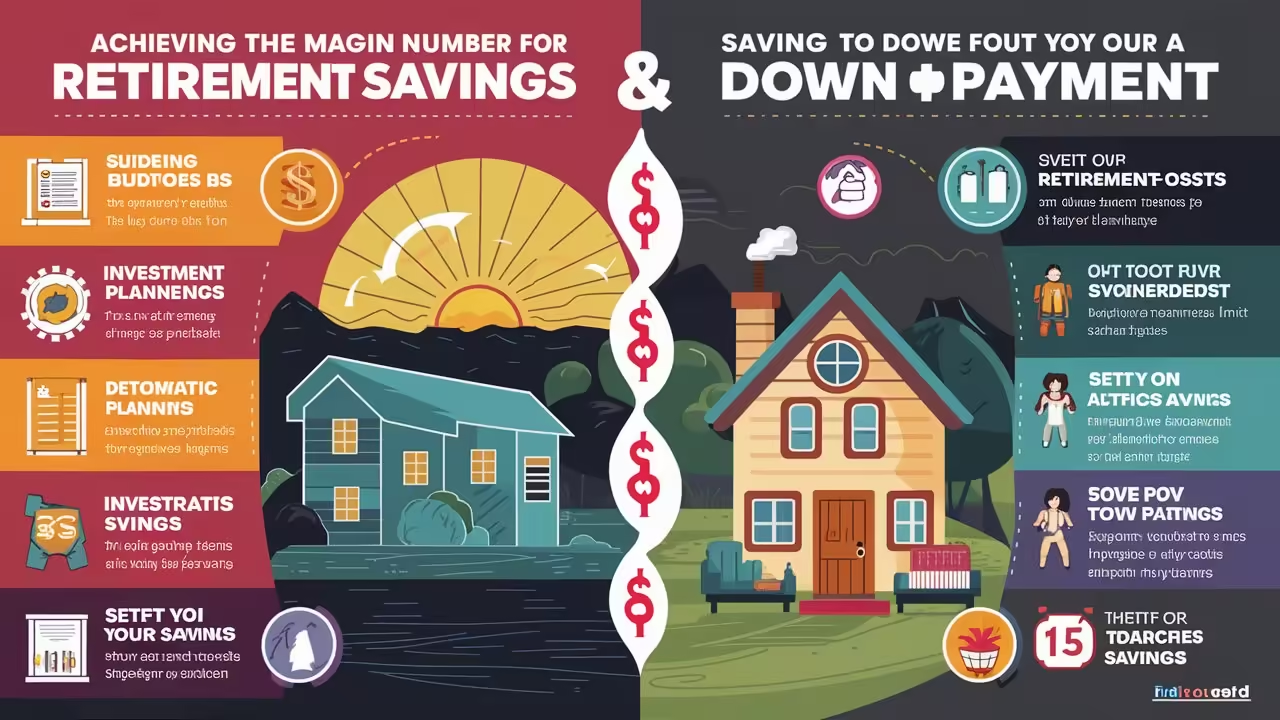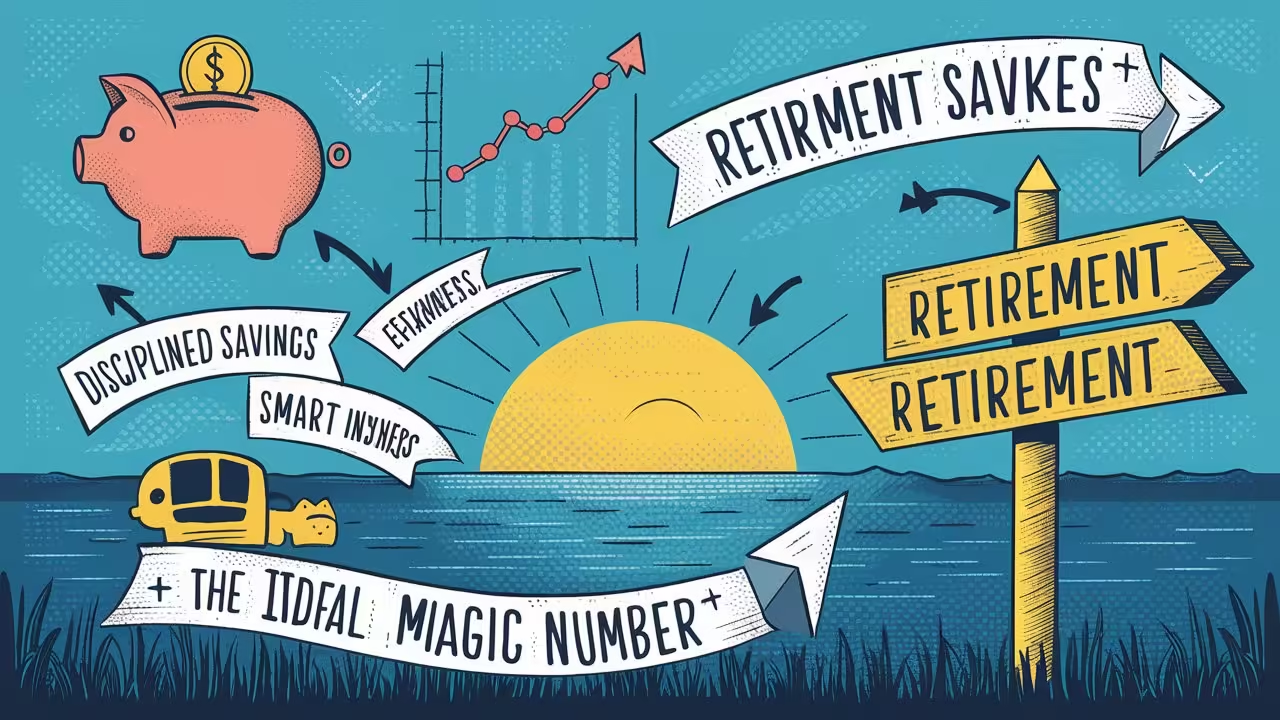Table of Contents
ToggleThe Retirement Savings Magic Number: Your Guide to Achieving Financial Goals
Achieving financial goals often feels like a daunting task, especially when these goals are significant and long-term, such as buying a house or retiring comfortably. Setting clear, achievable targets is crucial. This comprehensive guide will focus on two major financial objectives: the retirement savings magic number and saving for a down payment. We will explore strategies, tips, and actionable steps to help you reach these milestones with confidence and ease.

Understanding the Retirement Savings Magic Number
The retirement savings magic number is the amount of money you need to save by the time you retire to maintain your desired lifestyle without running out of funds. This figure varies based on individual circumstances, such as lifestyle preferences, anticipated expenses, and retirement age.
Why Knowing Your Retirement Savings Magic Number is Crucial
Understanding your retirement savings magic number provides a clear target, making it easier to plan and adjust your savings strategy over time. Without this figure, you might either under-save, risking financial insecurity in retirement, or over-save, potentially compromising your current quality of life.
How to Calculate Your Retirement Savings Magic Number
Calculating your retirement savings magic number involves estimating your annual expenses during retirement and multiplying this by the number of years you expect to live in retirement. Adjust for inflation and consider any other sources of income, such as Social Security or pensions. Online calculators and financial advisors can provide personalized estimates.
Steps to Achieve Your Retirement Savings Magic Number
- Start Early: The power of compound interest means that the earlier you start saving, the less you need to save each year.
- Regular Contributions: Make saving a habit by setting up automatic transfers to your retirement accounts.
- Employer Contributions: Maximize employer-sponsored retirement plans, taking full advantage of any matching contributions.
- Diversify Investments: Spread your investments across different asset classes to minimize risk.
- Adjust and Monitor: Regularly review your savings progress and adjust contributions or investments as needed.
Common Challenges and Solutions in Saving for Retirement
- High Living Expenses: Create a budget and identify areas where you can reduce spending.
- Debt: Focus on paying down high-interest debt first, then allocate more towards retirement savings.
- Market Volatility: Maintain a diversified portfolio and avoid making impulsive investment decisions.
Real-Life Examples of Successful Retirement Savings
Consider stories of individuals who achieved their retirement savings goals through diligent planning and disciplined saving. These examples can provide motivation and practical tips for your journey.
Saving for a Down Payment: A Critical Financial Goal
A down payment is a substantial upfront payment made when purchasing a home. It is typically expressed as a percentage of the home’s purchase price, with 20% being a common benchmark to avoid private mortgage insurance (PMI).
Importance of Saving for a Down Payment
Saving for a down payment reduces the amount you need to borrow, resulting in lower monthly mortgage payments and interest costs. It also demonstrates financial stability to lenders, potentially securing better loan terms.
Strategies for Saving for a Down Payment
- Set a Clear Goal: Determine the amount you need based on the type of home you wish to buy and the current real estate market.
- Create a Savings Plan: Break down your goal into manageable monthly savings targets.
- Cut Unnecessary Expenses: Reduce discretionary spending to increase your savings rate.
- Increase Income: Consider side jobs or freelance work to boost your savings.
- Utilize Savings Accounts: Open a high-yield savings account to earn interest on your savings.
Programs and Assistance for First-Time Homebuyers
Explore government programs, grants, and loans designed to assist first-time homebuyers. These can provide significant financial support and make homeownership more accessible.
Balancing Multiple Financial Goals
Balancing saving for retirement and a down payment requires careful planning and prioritization. Use the following strategies to manage both objectives effectively.
Prioritizing Your Financial Goals
Assess your financial situation and determine which goal should take precedence based on urgency, potential returns, and personal preferences. Often, it is advisable to first establish a solid retirement savings plan, as delaying retirement savings can have significant long-term impacts.
Creating a Dual Savings Strategy
- Allocate Wisely: Divide your savings between retirement and down payment goals based on your priorities and timelines.
- Flexible Budgeting: Adjust your budget to accommodate both savings targets, allowing for flexibility as your financial situation evolves.
- Track Progress: Regularly monitor your savings progress for both goals and make adjustments as needed.
The Role of Emergency Funds
Maintaining an emergency fund is crucial for financial stability. Ensure that you have a sufficient cushion to cover unexpected expenses, preventing you from dipping into your retirement or down payment savings.

Investment Options for Long-Term Goals
Different investment options can help you grow your savings more effectively over time. Consider the following:
- Stocks and Bonds: Stocks offer higher potential returns but come with greater risk. Bonds are generally safer but offer lower returns. A balanced portfolio typically includes both.
- Real Estate: Investing in real estate can provide steady income and appreciation over time. Consider rental properties or real estate investment trusts (REITs).
- Mutual Funds and ETFs: Mutual funds and exchange-traded funds (ETFs) offer diversification and professional management, making them suitable for long-term investors.
- Retirement Accounts: Maximize contributions to retirement accounts such as 401(k)s and IRAs. These accounts offer tax advantages and are designed specifically for long-term savings.
- Achieving Financial Independence: Financial independence means having enough savings and investments to support your lifestyle without needing to work. It requires diligent planning, disciplined saving, and smart investing.
Steps to Achieve Financial Independence
- Set Clear Goals: Define what financial independence means to you and set specific targets.
- Increase Savings Rate: Save a significant portion of your income, aiming for at least 20-30%.
- Invest Wisely: Focus on investments that offer growth potential and align with your risk tolerance.
- Live Below Your Means: Maintain a frugal lifestyle, avoiding unnecessary debt and expenses.
The Psychological Benefits of Financial Planning
Effective financial planning reduces stress and anxiety, providing peace of mind and a sense of control over your financial future. It allows you to enjoy your present life while ensuring future security.
The Role of Financial Advisors
Financial advisors can provide valuable guidance and support in achieving your financial goals. They offer personalized advice, help with investment decisions, and keep you accountable.
Choosing the Right Financial Advisor
- Credentials: Look for advisors with relevant certifications and experience.
- Fee Structure: Understand how the advisor is compensated and choose a fee structure that aligns with your interests.
- Personal Fit: Ensure that the advisor’s approach and communication style match your preferences.
Leveraging Technology in Financial Planning
Various apps and online tools can assist in tracking your savings, managing investments, and planning for future expenses. These tools offer convenience and accessibility, making it easier to stay on top of your financial goals.
Top Financial Planning Tools
- Budgeting Apps: Mint, YNAB (You Need a Budget)
- Investment Platforms: Vanguard, Fidelity, Robinhood
- Retirement Calculators: Online calculators from financial institutions
Future Trends in Financial Planning
The financial planning landscape is continually evolving, with trends such as robo-advisors, sustainable investing, and personalized financial services gaining popularity.
- Robo-Advisors: Robo-advisors use algorithms to provide automated, low-cost investment management. They are ideal for individuals looking for a hands-off approach to investing.
- Sustainable Investing: Sustainable or socially responsible investing focuses on companies that meet certain environmental, social, and governance (ESG) criteria. This approach aligns investments with personal values.
- Personalized Financial Services: Advancements in technology allow for more personalized financial advice, tailored to individual needs and preferences. This trend enhances the relevance and effectiveness of financial planning.
For more information regarding Finance Basic you can visit FinancewithAi Channel & Home
Frequently Asked Questions
What is a retirement savings magic number?
A retirement savings magic number is the amount of money you need to save by the time you retire to maintain your desired lifestyle without running out of funds.
How can I calculate my retirement savings magic number?
Calculate your retirement savings magic number by estimating your annual expenses during retirement, multiplying this by the number of years you expect to live in retirement, and adjusting for inflation.
What are the benefits of saving for a down payment?
Saving for a down payment reduces the amount you need to borrow, resulting in lower monthly mortgage payments and interest costs, and demonstrates financial stability to lenders.
How can I balance saving for retirement and a down payment?
Balance saving for retirement and a down payment by allocating your savings between both goals based on your priorities and timelines, and regularly adjusting your budget to accommodate both.
What investment options are best for long-term goals?
Consider stocks, bonds, real estate, mutual funds, ETFs, and retirement accounts for long-term goals, focusing on a diversified portfolio that aligns with your risk tolerance.
How can financial advisors help in achieving financial goals?
Financial advisors provide personalized advice, help with investment decisions, and keep you accountable, ensuring you stay on track to meet your financial objectives.
Conclusion
Achieving significant financial goals, such as reaching your retirement savings magic number and saving for a down payment, requires careful planning, disciplined saving, and strategic investing. By understanding your targets, leveraging available resources, and staying committed to your plan, you can secure a stable and prosperous financial future. Whether you are just starting your savings journey or looking to refine your strategy, the insights and tips provided in this guide will help you navigate the path to financial success.
Inbound Links:
- How to Create a Budget: Budgeting Tips
Outbound Links:
- Retirement Savings Calculators: Vanguard Retirement Calculator
- First-Time Homebuyer Programs: HUD First-Time Homebuyer Programs
Share this:
- Click to share on LinkedIn (Opens in new window)
- Click to share on Reddit (Opens in new window)
- Click to share on Tumblr (Opens in new window)
- Click to share on Pinterest (Opens in new window)
- Click to share on Pocket (Opens in new window)
- Click to share on Telegram (Opens in new window)
- Click to share on Threads (Opens in new window)
- Click to share on WhatsApp (Opens in new window)
- Click to share on Mastodon (Opens in new window)
- Click to share on Nextdoor (Opens in new window)
- Click to share on Bluesky (Opens in new window)
